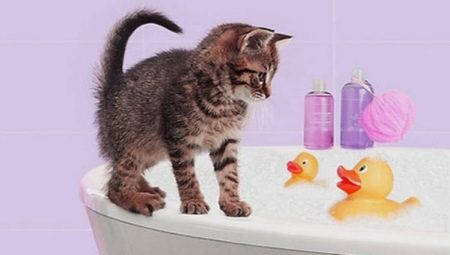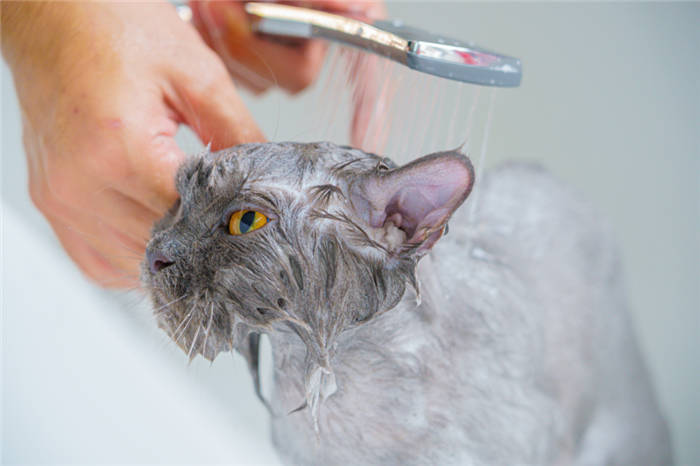Cats are very clean animals, they constantly lick themselves. Many owners believe that they do not need additional bathing.

- How often can a cat be bathed?
- Popular Questions
- When should I start bathing?
- How often should I bathe my kitten?
- How often should I wash my cat? Features of bathing
- When is bathing contraindicated?
- The bathing procedure and a few tips and tricks
- Veterinary advice
- Drying the coat after bathing
- How to wash a cat that is afraid of water
- Age-appropriate.
- Should I bathe?
- Tips and tricks
- How to dry a cat?
- When should a cat not be bathed?
How often can a cat be bathed?
Cats are predators, and their hunting instincts force them to frequently lick themselves and make sure they are hygienic so that potential prey will not smell them. That's why if you have an apartment cat you should wash it only when it gets dirty, but if it's a free-range cat you may have to wash it more often, but you shouldn't do it every day.
To avoid that the cat develops a fear of water and any hygienic procedures, it is better to accustom it to bathing, brushing ears, teeth and grooming from an early age. Kittens and adult cats should be washed with special shampoos for cats, human shampoos will not do. If the cat is afraid of water, act gently but firmly, don't punish the cat, but rather encourage it while bathing.
Anastasia Nikolina Expert in Royal Canin scientific support, veterinarian, specialist in veterinary dietetics and zoopsychology
Popular Questions
If you take an adult cat from the street you will need some time to teach him what a mother cat learns in the first months of life. First, find the right place for the litter box – it must be comfortable for both you and the cat, he must feel safe. Sometimes it's enough to put the litter tray and put the pet in it once – cats are clean and are pretty quick to accept your demands. If the cat will continue to urinate elsewhere, then place the litter tray there. Once the cat goes to the litter box a couple of times, you can move it to another location.
Anastasia Nikolina
Royal Canin science support expert, veterinarian, specialist in veterinary dietetics and zoopsychology
The most active phase of heat, estrus, the time when the cat is ready to mate, lasts about seven days. It is during this week that the cat may meow loudly, roll around on the floor, rub against various objects, and assume the mating posture when stroked. There are several ways to soothe these symptoms and calm the cat in heat.
- Distract the cat with frequent play, the more active the better.
- Try not to pet the cat: this may cause an ovulation reflex, which may be harmful if you do not plan to breed.
- If you're not planning to breed, also consider neutering your pet.
- Consult a veterinarian who will be able to recommend the right medication and the right regimen for it.
Anastasia Nikolina
Royal Canin scientific support expert, veterinarian, specialist in veterinary dietetics and zoopsychology
It would be better to have the tick removed from the cat at a veterinary clinic. If this is not possible, wear gloves or disinfect your hands and the bite area, then lubricate the body of the tick with a greasy cream that will make it difficult for it to breathe. After a while, gently twist the tick out with special tweezers. As a last resort, you can do it with your fingers wrapped in gauze.
When should I start bathing?
The earlier the kitten starts bathing, the calmer she will behave during this procedure when she is older. Ideally, if a kitten has been taught by the breeder from the first months of its life; if not – you should do it from the first weeks of its life in your home as soon as its adaptation period is over.
During first weeks of life there is no need to bathe a kitten, because at this age temperature changes, which are inevitable when bathing, can do more harm than good.
It is recommended to start bathing at age. Then they get used to this procedure from an early age, and later on there will be no problems with bathing.
How often should I bathe my kitten?
The optimal procedure is weekly bathing during the moulting period and once every two weeks for the rest of the time. Although it is better to listen to the wishes of the cat. Some run to bathe every time the bathtub is filled with water!
If soiled, if the cat went to the bathroom sloppily, or if there are parasites, you should bathe the kitten "off-plan". In this case, the frequency should be in accordance with the veterinarian's recommendations and guidelines for specific detergents.
If you find it necessary to wash more often, you should choose a product that will not dry out the coat and skin, and is suitable for your kitten.
How often should I wash my cat? Features of bathing

Bathing brings the cat not only benefits, but also some harm. The latter is due to the fact that during water procedures, sebum secretions that perform protective functions are washed off the skin and coat of the pet. Unlike humans, cats have relatively underdeveloped sweat glands, so if they bathe frequently, their skin will dry out and suffer from a lack of protective lubrication.
Too high a frequency of bathing is not desirable. Under normal circumstances, it is acceptable to bathe a cat about once every six months. If a pet is outdoors regularly, it can be bathed once every two months. Particularly thorough care is required for hairless cats – they should be bathed about once every two weeks during the warm season and once a month in winter. You can bathe out of turn in the cases mentioned above, but try not to abuse this opportunity.
There are three types of shampoos for cats: liquid, dry, and sprays. The liquid ones are the most effective, but you should take into account that they dry the skin and wash away the protective greasy layer.
When is bathing contraindicated?
Despite the need to help the cat maintain personal hygiene, there are exceptions when you have to postpone bathing your furry friend. This can happen if the pet has recently had a vaccination or surgery.
In the case of vaccinations, you will have to wait a short time. As for the surgery, the veterinarian will tell you after what time it will be possible to wash the cat. The problem is getting water on fresh stitches. This can lead to a number of unpleasant consequences, which are also life-threatening for the animal. Even if the traces of green, stitches and spit from them on the body of the pet spoil its appearance, it is better to be patient and preserve the health of the pet.
There is no need to bathe a cat that has just appeared at home. The pet will be acclimated, and it is unlikely to develop trust in the owner, which immediately after the acquisition causes negative emotions. In addition, it will be stressful for the pet to explore the new territory. There is no need to give him yet another reason to worry.

If the cat is expecting children, it is better to postpone the bathing until after the arrival of the babies. Taking a bath, the pet is under a lot of stress, which can adversely affect its health and the health of kittens. After giving birth, you don't need to rush either. Mama cat will devote all her time to taking care of her offspring, and an attempt to separate her from her children may serve as a loss of trust in the owner.
It is also not advisable to bathe baby cats before they are four months old. They have a harder time with water and sudden changes in conditions and temperature. Kittens are more mischievous than adult animals, and it may seem that they need to be bathed more often. But that is absolutely not the case!
The bathing procedure and a few tips and tricks
The most questions arise when it comes directly to bathing the cat. To begin with you should be prepared for the animal's negative reaction to water. Also, if possible, it is better to invite a helper, because you probably cannot do it alone. It is recommended to pet the cat before bathing and to make him feel secure. This will not guarantee that the cat will be completely calm, but it will at least soften his worries.
In no case you should not lose sight of such a factor as the body temperature of cats. It is higher than in humans, so the bath water should be hotter, but not too scalding. Recommended – 35-39 ° C. This is important, because from the sharp changes in temperature the animal not only suffers stress, but also becomes more vulnerable to disease.

In addition to the cat, the owner should also prepare himself. It is important to keep a dry, clean towel with which to wrap the animal completely, a special comb and, if necessary, a hair dryer, although it is still not advisable to use one. In addition to having this equipment, it is important to make sure there are no open doors. No drafts should be allowed, as cats are very delicate animals, and they are susceptible to the cold.
You should also be very careful when choosing a shampoo. Of course, in no case should we use products for people. They dry out the pet's skin and cause itching. There is a large selection of shampoos for cats of different breeds and ages in veterinary stores. There is also a separate type of shampoo for a pet that has fleas or other parasites on it.
You should never attempt to wash your pet's muzzle and ears under the tap or shower. If water gets into the ear canals, it can be fraught with deafness of the pet, possibly even more dire consequences. The muzzle can be washed with a damp cloth or absorbent cotton soaked in water. This should be sufficient.
Veterinary advice
Even if the pet belongs to the category of those animals that require frequent baths, it is not recommended to perform this procedure more than 6 times a year. In some cases, it is better to combine water procedures with dry bathing, in which special powder shampoos are used.
It must be remembered that During the cold season, cats and pets are washed less often. If the apartment is cool, you should not rush with bathing. Animals become very cold after bathing, so they can easily catch cold in a cool place (especially if there are drafts). For this reason, after bathing the cat or cat should be placed in a warm room with no draughts.
In very hot weather, some inexperienced cat breeders try to bathe their pets more often or just rinse them with water. According to veterinarians, there is no need to do this. To ease the cat's condition in the heat, you can use the following recommendations:
- Place a damp towel or clean cloth dampened with water near the cat's bed;
- Spray a little water on the cat's face and ears with the palm of your hand;
- Ensure the cat has unrestricted access to clean water;
- Wipe the cat periodically with a wet cloth.
In an effort to help the pet endure the heat with the least amount of suffering, some owners use air conditioners and fans. Often these devices cause severe colds in cats and cats.
Categorically do not allow the animal to be in a room with a fan or air conditioner after bathing.
The frequency of bathing cats and cats is a relative indicator that depends on the individual characteristics of the animal, its lifestyle, age, health and living conditions. Caring and attentive owners are well aware of these parameters, so they have no trouble determining when it is time to bathe their pets.
Drying the coat after bathing
Take the freshly washed cat into the room and wipe it dry with a towel. For short-haired cats one towel will be enough, but for long-haired cats, don't spare 2-3. You can put the cat on a newspaper or a hoe, so that the dripping moisture can be absorbed faster.
FYI: the cat has what is called an air cushion between the skin and the top layer of hair. This air layer is heated by the cat's body heat and protects the cat from freezing. During bathing the cat's fur gets soaked and temporarily loses its thermo-regulating feature, which is why it is so important to warm the cat with towels after bathing and to protect it from draughts.
If the cat is not afraid of the hair dryer, then about 10 minutes after bathing you can dry the hair slightly. The air flow should be warm, but not hot. In case the cat is afraid of the electric appliance, it is better to wait until the "coat" dries naturally.
After washing, the domestic cat should stay warm for at least an hour.
How to wash a cat that is afraid of water
What to do if the cat is afraid of water? Will you have to give up bathing completely? This problem is solvable – show patience and wit.
Firstly, don't neglect clipping the claws before bathing, because especially impressionable cats become very belligerent during bath time.
Then play with the cat and make him feel relaxed and exhausted. Do not feed the cat.
After putting the whiskered, striped cat to sleep, proceed with the washing. Lower the cat into the water gradually, distracting him with toys. The water should be poured in advance, so that the cat won't wait too long and won't be frightened by the unfamiliar sound.
No matter how the cat behaves during the bathing, you should not yell at it or punish it physically – this will only bring the animal additional stress. You can use a special net for bathing, where the cat is placed like in a sack and doesn't go anywhere. Maybe it will remind him of his favorite box?
Give the cat a treat when the bath is over, so he knows he'll be rewarded for the bath!
If your pet still can't get over his or her panic fear of water, you can wash him or her with dry shampoo. This is a great alternative to traditional washing, as a good dry shampoo cleans almost as well as a liquid shampoo. Apply the powder to your cat's coat, wait a minute and brush the powder off along with the dirt.
Age-appropriate.
At one month of age or even earlier, bathing a kitten is not allowed, as this process can disrupt the temperature regime and wash away the fat film from the baby's skin, thereby opening up access to dangerous bacteria. At this age, the mother's way of washing is sufficient. The mother cat carefully licks her offspring, which ensures their hygiene. After one month of age, the kitten is allowed to bathe very carefully only when he is completely accustomed to the owners and the apartment and will not be afraid of anything. By this time it will be stronger and better educated to lick itself.
If a very young pet gets dirty, and it has not yet learned how to lick itself, it is recommended to clean the dirty areas with a damp cloth, without exposing the baby to the stress of bathing.
Usually kittens are not given away immediately after birth, they are found new owners at the age of 2-2.5 months, until then they are under the care of a mother cat, and when moved to a new home they can begin to be bathed. The most favorable age is 3 months. Just by this age, the kitten's body becomes strong and will be able to endure the bathing procedure without colds and other complications. If the kitten is vaccinated, you can bathe no sooner than 2 weeks after vaccination.
If everything is clear with owners' kittens, the situation is different with stray kittens. It is important to take the kitten immediately to the vet for the preliminary examination and tests, and if the expert recommends bathing the kitten without waiting until he is 3 months old, then you should do so. In this case the bathing of a pet is not just a hygienic procedure, but a way to treat the hair against fleas, fungi and other parasites.
Should I bathe?
In total, it is recommended to bathe your pet once every 3 months, but there is nothing wrong with the owner refusing to bathe your pet. Cats are clean animals and are capable of maintaining their own body hygiene. This is especially true for those animals that are kept exclusively in the house.
However, there are several reasons to bathe your pet periodically.
Bathing procedures are especially important for purebred animals, such as British or Scottish lop dogs.
- During shedding, the cat, by licking itself with its tongue, swallows some of the hairs, which often contain harmful substances. All of this gets into the cat's stomach, causes the animal discomfort and can provoke illness. This is especially true for kittens, their stomachs are not yet strong. During bathing, some of the hair is washed away with water, which means that the animal has less chance of ingesting elements that are harmful to its body.
- It is important to rid the outdoor kitten of various parasites. Special pills, sprays and suspensions can be dangerous for the baby, the weak body, deprived of immunity during outdoor life, can not withstand the toxicity of special drugs. Therefore, washing with flea shampoo may be the only solution to the problem.
Tips and tricks
To ensure that water procedures do not harm the pet, you need to follow the recommendations of veterinarians:
- Do not bathe cats more often than once every 2 months;
- If necessary, you should wipe the dirty area with a wet towel or use dry shampoo;
- don't direct the shower at their muzzle, water may get into their ears and cause inflammation or even deafness;
- When it's cold, wash less often until the coat is dry and protected from drafts;
- feed the cat at the latest 2-3 hours before bathing, because stress may make the cat vomit;
- clippings should be trimmed before bathing to avoid scratching;
- In summer in the heat it is not necessary to increase the frequency of bathing, you can alleviate the condition of the cat by periodically spraying it with water from a sprayer or wiping it with a damp towel.
Frequent bathing of cats is not recommended. For pets, once every 3-4 months is enough. The frequency of bathing depends on many factors. There are situations when an unscheduled wash is required. Determining that a cat is dirty is easy: its hair is shiny, piles up in tangles or gathers in icicles, there is an unpleasant smell. If you do it right and follow the veterinarians' advice, the pet won't be stressed.
How to dry a cat?
Immediately after washing, the cat should be wrapped in a dry towel. You can use several towels in turn, until the cat's coat gives up most of the moisture. Next, you need to dry them with a hair dryer. Long-haired cats are recommended to be combed out with a brush. Then move the cat to a warm, quiet place and let it calm down.
There are many different opinions about this; scientists have not yet come to one answer. But there are three most plausible reasons:
- The animal's fur gets wet and becomes heavy. This causes the cat to turn from a skilled hunter to an easy prey, something that its instincts constantly remind it of.
- When wet, the coat becomes cold and no longer keeps the animal warm. The cat freezes, which she does not like.
- If a cat has had a bad experience with water, it will remember it for life.
When should a cat not be bathed?
- After surgery. The first bathing procedures for operated animals may not be recommended before 3-4 months.Be sure to clarify this with your veterinarian
- During pregnancy. The bathing itself is not harmful for the cat, the stress of the procedure and the fact that the cat will tear itself away or hit the rim of the bathtub is dangerous.
Now you know how and what to wash the cat so that he does not produce a specific smell, as well as many other nuances of this procedure. Remember – the main thing is always to show your cat that you love him.






